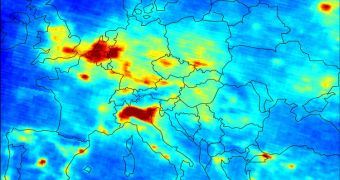The European Space Agency's (ESA) Envisat satellite turned 10 years old in Earth's orbit yesterday, March 1. This is a joyous moment for the organization, and an important milestone for the tremendously successful, Earth-monitoring mission.
It took to the skies on March 2, 2002, at 01:07 UTC, aboard an Ariane 5 heavy-lift delivery system provided by Arianespace. Launch occurred from the Kourou Spaceport, in French Guiana, South America. Envisat is placed on a Sun-synchronous polar orbit featuring an inclination of 98.6°.
At 8,211 kilograms (18,100 pounds), the satellite is one of the heaviest and largest ever dedicated to monitoring our planet's orbit. The spacecraft takes a little more than 100 minutes to complete a trip around Earth, and passes above the exact same spot once every 35 days.
Its primary cargo is a suite of 5 scientific instruments, of which the MEdium Resolution Imaging Spectrometer (MERIS) is the most famous. It also features another spectrometer, two radiometers, a stellar occultation camera and a spectrometer. There are 10 instruments in total.
Yesterday, Envisat exceeded its planned mission time twice over. Thus far, it orbited the planet more than 50,000 times. This enabled it to compile sufficient data for up to 2,000 scientific papers on various aspects of our planet's surface and atmosphere.
One of the most important (and largest) instruments on the spacecraft is the Advanced Synthetic Aperture Radar (ASAR), which is able to pierce darkness and cloud covers. This is essential for monitoring the polar regions, for example, where weather conditions are oftentimes very severe.
“With an increased demand from scientific users for Envisat products, the mission gradually increased the flow of data within the first five years. Ground facilities have improved over the years to speed the delivery of data and their quality,” ESA says in a press release.
“In 2004, the mission’s first scientific results were presented at the Envisat Symposium in Salzburg, Austria. With about 1,000 participants, it marked the establishment of Envisat as one of the major tools available to Earth scientists,” the document adds.
“Three years later, another symposium dedicated to Envisat included the first global measurements of greenhouse gases, demonstrating the fast-growing concentration of carbon dioxide and the seasonal variation of methane,” ESA officials conclude.

 14 DAY TRIAL //
14 DAY TRIAL //